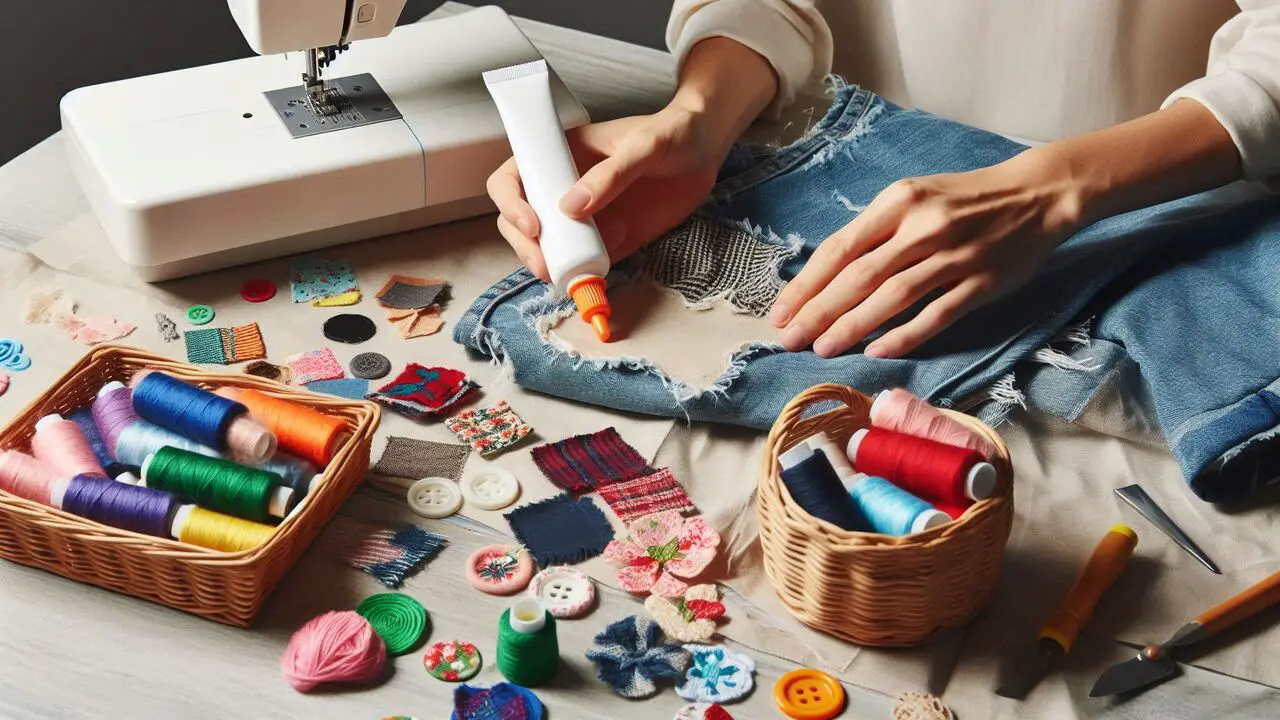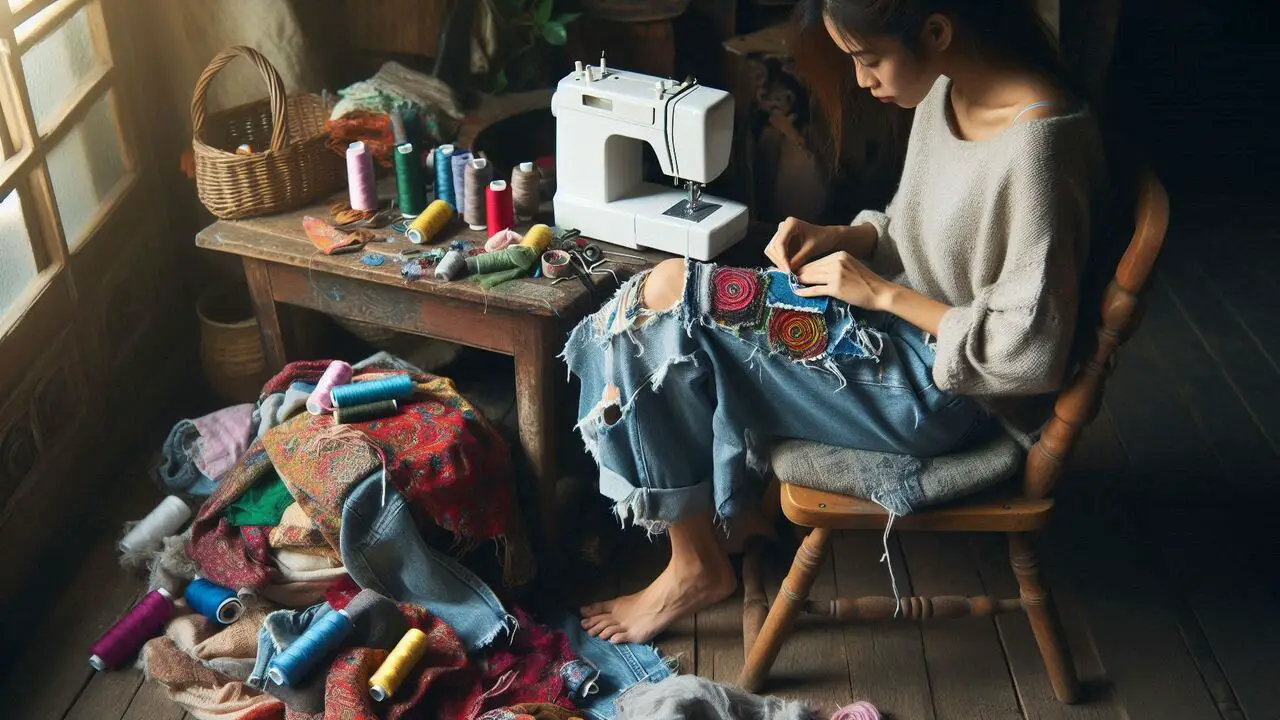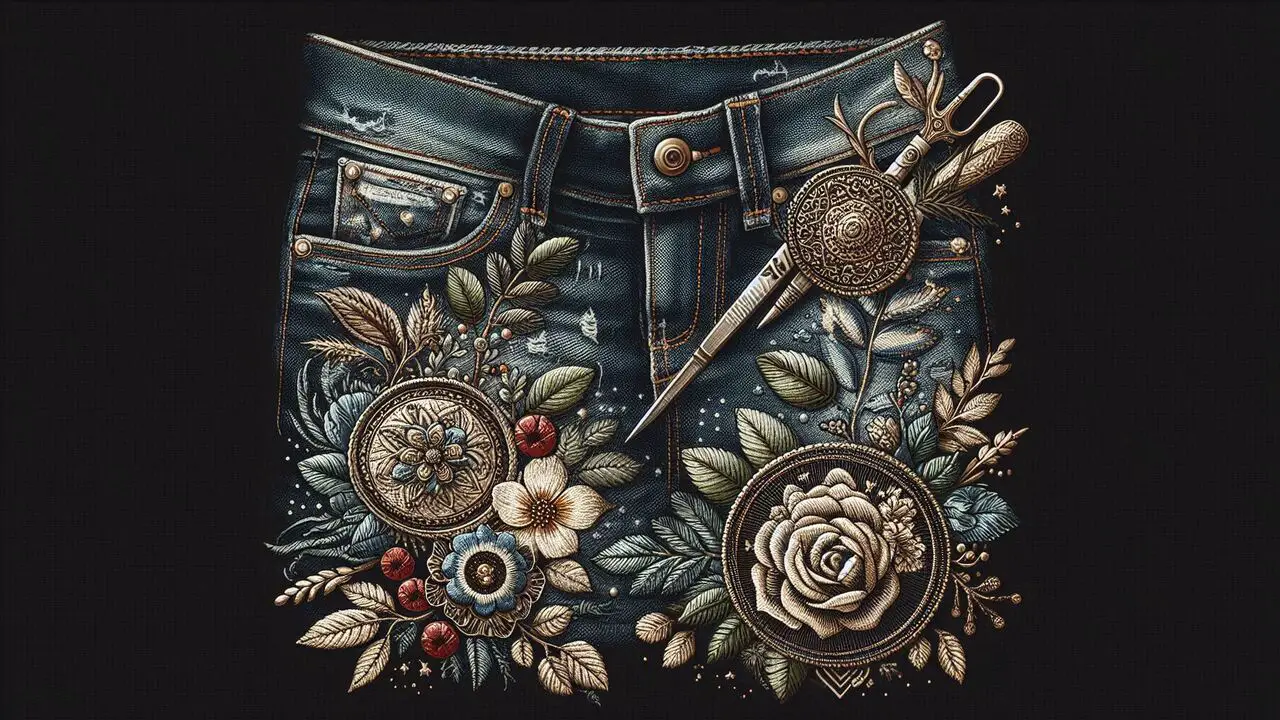Distressed jeans have become a staple in many wardrobes, offering a casual, edgy look that never goes out of style. However, as much as we love the worn-in, lived-in look of distressed jeans, wear and tear can often lead to rips, tears, and fraying, making them look more shabby than chic.
But fear not. With a few simple techniques and some basic tools, you can easily revive your distressed jeans and give them new life.
Here, we will discuss the best techniques for fixing distressed jeans to ensure they look as good as new. So, if you’re ready to breathe new life into your distressed denim collection, read these expert methods to fix distressed jeans like a pro.

How To Fix Distressed Jeans – With Simple Methods

Distressed jeans have become popular for those looking to add a touch of edginess to their wardrobe. These jeans are characterized by their intentionally worn and torn appearance, giving them a unique and stylish appeal. Here are 6 handy mathods to fix distressed jeans:
Method 1: Patching with Fabric Glue

Materials Needed:
- Denim patch or fabric scrap
- Fabric glue
- Scissors
- Iron (optional)
Instructions:
- Cut a piece of denim or fabric slightly larger than the damaged area.
- Place the patch on the inside of the jeans,
- Covering the hole. Apply fabric glue around the edges of the patch.
- Press the patch firmly onto the jeans and let the glue dry completely.
- For added security, you can lightly iron the patch if the glue instructions allow it.
Method 2: Sewing a Patch

Materials Needed:
- Denim patch or fabric scrap
- Needle and thread (matching color)
- Scissors
- Pins
Instructions:
- Cut a patch slightly larger than the damaged area with rounded corners.
- Place the patch inside the jeans and pin it in place.
- Use a whip stitch or blanket stitch to sew around the edges of the patch.
- Securing it to the jeans.
Method 3: Iron-On Patch

Materials Needed:
- Iron-on denim patch
- Iron
- Ironing board
Instructions:
- Place the iron-on patch on the inside of the jeans, covering the hole.
- Press a hot iron over the patch for a specified amount of time.
- Allow the patch to cool and check its adhesion.
- Reinforce with stitches if necessary.
Method 4: Darning
Materials Needed:
- Needle and thread (matching color)
- Scissors
- Darning egg or small, rounded object
Instructions:
- Turn the jeans inside out and place a darning egg under the damaged area.
- Use a needle and thread to weave stitches back and forth across the hole.
- Creating a woven pattern that mimics the original fabric.
- Once the hole is filled, tie off the thread and trim any excess.
Method 5: Decorative Patches or Embroidery

Materials Needed:
- Decorative patches or embroidery thread
- Needle
- Scissors
- Fabric glue (optional)
Instructions:
- Choose a decorative patch or plan an embroidery design to cover the damaged area.
- Sew or glue the decorative patch over the hole.
- If embroidering, use a needle and thread to create a design that reinforces the fabric.
- Ensure the patch or embroidery is secure and trim any excess thread.
Method 6: Fabric Backing with Stitching
Materials Needed:
- Fabric backing (denim or other sturdy fabric)
- Needle and thread or sewing machine
- Scissors
- Pins
Instructions:
- Cut a piece of fabric slightly larger than the damaged area.
- Place the fabric backing inside the jeans and pin it in place.
- Use a sewing machine or hand stitch to sew around the edges of the damaged area.
- Securing the backing fabric in place.
Maintenance And Care For Your Repaired Distressed Jeans

Maintaining and caring for your repaired distressed jeans, you should follow a few key steps to ensure their longevity and continued stylish appearance.
- Washing: When washing your repaired distressed jeans, it is best to turn them inside out before placing them in the washing machine. This helps to protect any repaired areas and prevent further damage. Use a gentle cycle and cold water to minimize color fading.
- Drying: Avoid using a dryer for your distressed jeans, as the heat can cause the repaired areas to deteriorate. Instead, air drying is recommended. Hang them up or lay them flat to dry naturally.
- Ironing: If your distressed jeans require ironing, it is important to do so carefully. Iron them inside out on a low heat setting to avoid damaging repaired sections or embellishments.
- Storage: Proper storage is essential to maintain the quality of your distressed jeans. Fold them neatly and store them in a cool, dry place away from direct sunlight. Avoid hanging them for long periods, as this can cause stretching and distortion.
- Spot Cleaning: If you notice any stains or spills on your distressed jeans, it is best to spot-clean them immediately. Use a mild detergent or stain remover and gently dab the affected area with a clean cloth. Avoid rubbing vigorously, as this can damage the repaired sections.
- Regular Inspections: It is a good idea to regularly inspect your distressed jeans for any signs of wear and tear. If you notice any loose threads or additional distressing, address them promptly to prevent further damage.
Conclusion
Reviving distressed jeans is a rewarding way to extend their lifespan and maintain their stylish edge. Whether you choose fabric glue, sewing, iron-on patches, darning, decorative patches, or fabric backing, each method offers a unique solution to mend tears and frays.
Remember to handle them with care during washing, drying, and ironing to preserve your repairs. By following these techniques and caring for your jeans diligently, you can confidently rock your revamped distressed denim for seasons to come.
FAQ
1.How Do You Distress Jeans Without Ruining Them?
One way to distress jeans without ruining them is by using sandpaper or a pumice stone to rub the areas you want to distress. Start with light pressure and gradually increase it until you achieve the desired effect. Another method is using a razor blade or scissors to carefully cut small cuts or tears in the fabric.
2.How Can I Fix A Hole In My Jeans Without Sewing?
One option is fabric glue or fabric tape to patch the hole. Apply a small amount of glue or tape to the edges of the hole and press a piece of fabric onto it. Make sure to smooth out any wrinkles or bubbles and let it dry completely before wearing. Another option is to use iron-on patches.
3.How To Keep Distressed Jeans From Fraying?
You can reinforce the edges with zigzag stitches or fabric patches to prevent fraying on distressed jeans. Another option is to apply a small amount of fabric glue to the frayed areas to secure the threads in place. Additionally, avoid excessive washing and drying of the jeans, as this can accelerate fraying.
4.How To Repair Distressed Denim?
To repair distressed denim, scrap fabric or denim, embroidery floss, fabric scissors, and a sewing machine. First, cut a piece of scrap fabric to cover the hole or tear. Place it under the distressed area and sew it in place using a straight or zigzag stitch. You can also add embellishments like lace or embroidery to make the repair more stylish.
5.How Do You Stop Tearing The Crotch In Your Jeans?
- Use scrap denim or fabric to reinforce the crotch area.
- Apply a denim patch by hand sewing or straight stitching.
- Opt for embroidery floss for added durability.
- Consider adding horizontal lines or zigzag stitches for extra reinforcement.
- Use fabric scissors to cut and mend any torn areas properly.
6.How To Fix Distressed Jeans With A Hole In The Back Pocket?
To fix distressed jeans with a hole in the back pocket, scrap denim and embroidery floss can patch the small hole. Start by cutting a denim patch with fabric scissors and securing it by hand sewing using a straight stitch or zigzag stitch. You can also add decorative elements like lace or additional stitching.
7.How To Fix Distressed Jeans With A Tear In The Knee?
To fix distressed jeans with a tear in the knee, you can use scrap fabric, denim patches, embroidery floss, and hand sewing to mend the tear. Cut a scrap fabric or denim patch to cover the tear, and secure it with a straight stitch or zigzag stitch along the frayed edges.
For added durability, reinforce with a horizontal line of stitching and add some decorative embroidery if desired. Trim any excess fabric with fabric scissors, and your favorite distressed jeans will be as good as new!
8.What Material Works Best For Patching Jeans?
For patching jeans, scrap denim, fabric scissors, hand sewing, embroidery floss, and denim patches are commonly used materials and techniques. Just cut a piece of scrap denim, sew it onto the torn area using a straight stitch or zigzag stitch, and reinforce it with embroidery floss for durability. This method is especially effective for ripped jeans, distressed denim, or torn areas like the knee or pocket.
9.How To Fix Distressed Jeans Without Sewing?
Fixing distressed jeans without sewing can be done effectively with a few creative and practical methods:
- Iron-on Patches
- Fabric Glue or Fusible Web
- Fabric Markers or Paints
- Darning or Visible Mending
- Embellishments
- Distressing Further
10.Can Distressed Jeans Be Fixed Without Sewing?
Yes, distressed jeans can be fixed without sewing by using fabric glue, iron-on patches, or fabric tape.










